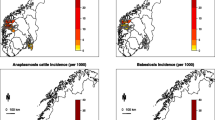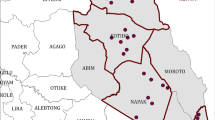Abstract
As part of the epidemiological studies aimed at developing an East Coast fever (ECF) immunisation control strategy, which combines an infection and treatment method with strategic tick control, a countrywide tick survey was carried out in both the dry and the wet season to determine the abundance and the dynamics of the tick populations infesting cattle in Rwanda. Six Ixodid tick species where identified from a total of 12,814 tick specimens collected. Rhipicephalus appendiculatus, the main vector of ECF was the most abundant (91.8%) followed by Boophilus decoloratus (6.1%) and Ambyomma variegatum (1.2%). Few ticks from the three other less economically important Ixodid species (Rhipicephalus compositus, R. evertsi evertsi and Ixodes cavipalpus) were recovered. Both adult and immature stages of the most dominant tick species were found to be widespread with a year round presence. The numbers of ticks were high in low land and medium zones and declined markedly in the higher regions of Rwanda. The geographical distribution of various tick species throughout the country and their epidemiological implications are discussed.


Similar content being viewed by others
References
Bazarusanga T (1999) Molecular characterisation of T. parva parasites in the field of Rwanda. MSc. Thesis 85, Institute for Tropical Medicine, Antwerp, Belgium
Bazarusanga T, Vercruysse J, Marcotty T, Geysen D (2007) Epidemiological studies on Theileriosis and the dynamics of Theileria parva infections in Rwanda. Vet Parasitol 143:214–221
Beati L, Keirans JE (2001) Analysis of the systematic relationships among ticks of the genera Rhipicephalus and Boophilus (Acari: Ixodidae) based on mitochondrial 12S ribosomal DNA gene sequences and morphological characteristics. J Parasitol 87:32–48
Berggren SA (1978) Cattle ticks in Malawi. Vet Parasitol 4:289–297
Berkvens DL, Geysen DM, Chaka G, Madder M, Brandt JRA (1998) A survey of the Ixodid ticks parasitizing cattle in the Eastern province of Zambia. Med Vet Entomol 12:234–268
Cummings GS (2002) Comparing climate and vegetation as limiting factors for species ranges of African ticks. Ecology 83:255–268
Davis MB, Shaw RG (2001) Range shifts and adaptive responses to quaternary climate change. Science 292:673–679
Estrada-Peña A (2003) Climate change decreases habitat suitability for some tick species (Acari: Ixodidea) in South Africa. Onderstepoort J Vet Res 70:79–93
Estrada-Peña A, Bouattour A, Camicas J-L, Guglielmone A, Horak I, Jongejan F, Latif A, Pegram R, Walker AR (2006) The known distribution and ecological preferences of the tick subgenus Boophilus (Acari: Ixodidae) in Africa and Latin America. Exp Appl Acarol 38:219–235
FAO (1982) Rwanda. Epizootiology and control of tick-borne diseases. Technical report No. 1. AG: RW/ 77/ 006. Food and Agriculture Organisation, Rome 78 pp
Hlatshwayo M, Mbati PA, Dipeolu OO (2002) Seasonal abundance of adult ixodid ticks infesting cattle belonging to resource-limited farmers in the north-eastern Free State Province of South Africa. Onderstepoort J Vet Res 69:1–6
Hutchinson GE (1957) Concluding remarks. In population studies: animal ecology and demography. Cold spring Harbor Symposia on Quantitative Biology, vol 22. Cold Spring Harbor Laboratory Press
Kaiser MN, Sutherst RW, Bourne AS (1982) Relationship between ticks and Zebu cattle in Southern Uganda. Trop Anim Health Prod 14:63–74
Kaiser MN, Sutherst RW, Bourne AS, Gorissen L, Floyd RB (1988) Population dynamics of ticks on Ankole cattle in five ecological zones in Burundi and strategies for their control. Prev Vet Med 6:199–222
Lightfoot CJ, Norval RAI (1981) Tick problems in Wildlife in Zimbabwe. 1. The effects of tick parasitism on wild ungulates. S Afr J Wildlife Res 60:253–274
MacIvor KM de F, Horak IG (2003) Ixodid ticks of Angora and Boer goats, grysbok, common duikers, kudus and scrub hares in Valley Bushveld in the Eastern Cape Province, South Africa. Onderstepoort J Vet Res 70:113–120
MacLeod J, Mwanaumo B (1978) Ecological studies of ticks (Acari: Ixodidae) in Zambia. IV: Some anomalous infestation patterns in the Northern and Eastern regions. Bull Entomol Res 68:409–429
Madder M, Speybroeck N, Brandt J, Tirry L, Hodek I, Berkvens D (2002) Geographic variation in diapause response of adult Rhipicephalus appendiculatus ticks. Exp Appl Acarol 27:209–221
Matthysse JG, Colbo MH (1987) The Ixodid ticks of Uganda. Entomological Society of America. College Park, Maryland
McCulloch B, Kalaye WJ, Tungaraza R, Suda B’QJ, Mbasha EMS (1968) A study of the life history of the tick Rhipicephalus appendiculatus – the main vector of East Cost fever – with reference to its behaviour under field conditions and with regard to its control in Sukumaland, Tanzania. Bull Epiz Dis Afr 16:477–500
Mukhebi AW, Kariuki DP, Mussukuya E, Mullins G, Ngumi PN, Thorpe W, Perry BD (1995) Assessing the economic impact of immunisation against East Coast fever: a case study in Coast Province, Kenya. Vet Rec 137:17–22
Murrell A, Campbell NJH, Barker SC (2000) Phylogenetic analyses of the Rhipicephaline ticks indicate that the genus Rhipicephalus is paraphyletic. Mol Phylogen Evol 16:1–7
Norval RAI (1982) The ticks of Zimbabwe. IV. The genus Hyalomma. Zimbabwe Vet J 13:2–10
Norval RAI (1994) Factors affecting the distributions of the ticks Amblyomma hebraeum and A. variegatum in Zimbabwe: implications of reduced acaricide usage. Exp Appl Acarol 18:383–407
O’Kelly JC, Seifert GW (1969) Relationship between resistance to Boophilus microplus, nutritional status, blood composition of Shorthorn x Hereford cattle on high and low planes of nutrition. Australian J Biol Sci 22:1497–1506
Olwoch JM, Rautenbach CJ de W, Erasmus BFN, Englebrecht BFA, Jaarsveld AS (2003) Simulating tick distributions over sub-Saharan Africa: the use of observed and simulates climate surfaces. J Biogeogr 30:1221–1232
Paling RW, Geysen D (1981) Observations on Rwanda strains of Theileria parva and the value of T. parva Nyakizu as a possible vaccine strain. In: Irvin AD, Cunningham MP, Young AS (eds) Advances in the control of Theileriosis: Proceedings of an international conference held at ILRAD, Nairobi, 9–13 February, 1981. Martinus Nijhoff Publishers, The Hague, pp 238–241
Pearson RG, Dawson TP (2003) Predicting the impacts of climate change on the distribution of species: are bioclimate envelope models useful? Global Ecol Biogeogr 12:361–371
Pegram RG, James AD, Bamhare C, Dolan TT, Hove T, Khanai GK, Latif AA (1996) Effects of immunisation against Theileria parva on beef cattle productivity and economics of control options. Trop Anim Health Prod 28:99–111
Pegram RG, Mwase ET, Zivkovic D, Jongejan F (1988) Morphogenetic diapause in Amblyomma variegatum (Acari: Ixodidae). Med Vet Entomol 2:301–307
Peter TF, Perry BD, O’Callaghan CJ, Medley GF, Shumba W, Madzima W, Burridge MJ, Mahan SM (1998) Distributions of the vectors of heartwater, Amblyomma hebraeum and Amblyomma variegatum (Acari: Ixodidae), in Zimbabwe. Exp Appl Acarol 22:725–740
Punyua DK, Latif AA, Nokoe S, Capstick PB (1991) Tick (Acari: Ixodidae) infestations on Zebu cattle in Western Kenya: seasonal dynamics of four species of ticks on traditionally managed cattle. J Med Entomol 28:630–636
Radley DE (1981) Infection and treatment method of immunization against Theileriosis. In: Irvin AD, Cunningham MP, Young AS (eds) Advances in the control of Theileriosis: Proceedings of an international conference held at ILRAD, Nairobi, 9–13 February, 1981. Martinus Nijhoff Publishers, The Hague, pp 227–236
Randolph SE, Rogers DJ (1997) A generic population model for the African tick Rhipicephalus appendiculatus. Parasitology 115:265–279
Randolph SE (1994) Population dynamics and density-dependant seasonal mortality indices of the tick Rhipicephalus appendiculatus in Eastern and Southern Africa. Med Vet Entomol 8:351–368
Randolph SE (1997) Abiotic and biotic determinants of the seasonal dynamics of the tick Rhipicephalus appendiculatus in South Africa. Med Vet Entomol 11:25–37
Theiler G (1962) The Ixodidae parasites of vertebrates in Africa South of Sahara (Ethiopian region), Projects S 9958. Report to the Director of Veterinary services, Onderstepoort
Tønnesen MH, Penzhorn BL, Bryson NR, Stoltz WH, Masibigiri (2004) Displacement of Boophilus decoloratus by Boophilus microplus in the Soutpansberg Region, Limpopo Province, South Africa. Exp Appl Acarol 32:199–208
Walker AR, Bouattour A, Camicas J-L, Estrada-Peña A, Horak IG, Latif AA, Pegram RG, Preston PM (2003) Ticks of domestic animals in Africa: a guide to identification of species. Bioscience Reports, UK
Yeoman GH, Walker JB (1967) The Ixodid ticks of Tanzania. Commonwealth Institute of Entomology, London
Zieger U, Horak IG, Cauldwell AE, Uys AC, Bothma J, Du P (1998) The effect of chemical tick control on cattle on free-living ixodid ticks and on ticks parasitic on sympatric Impala in the Central Province, Zambia. S Afr J Wildlife Res 28:10–15
Acknowledgement
This study was made possible through the financial support of the VLIR and the assistance from technical staff of the National Veterinary Laboratory of Rwanda (Francisca R. Mudaheranwa, Jeanne M. Uwamahoro, Ernest Munyagishali and J. Claude Ndolimana). We are also thankful to Dr Rutagwenda Theogen and Dr Gafarasi Isidore (RARDA) for logistic support and useful advices.
Author information
Authors and Affiliations
Corresponding author
Rights and permissions
About this article
Cite this article
Bazarusanga, T., Geysen, D., Vercruysse, J. et al. An update on the ecological distribution of Ixodid ticks infesting cattle in Rwanda: countrywide cross-sectional survey in the wet and the dry season. Exp Appl Acarol 43, 279–291 (2007). https://doi.org/10.1007/s10493-007-9121-y
Received:
Accepted:
Published:
Issue Date:
DOI: https://doi.org/10.1007/s10493-007-9121-y




